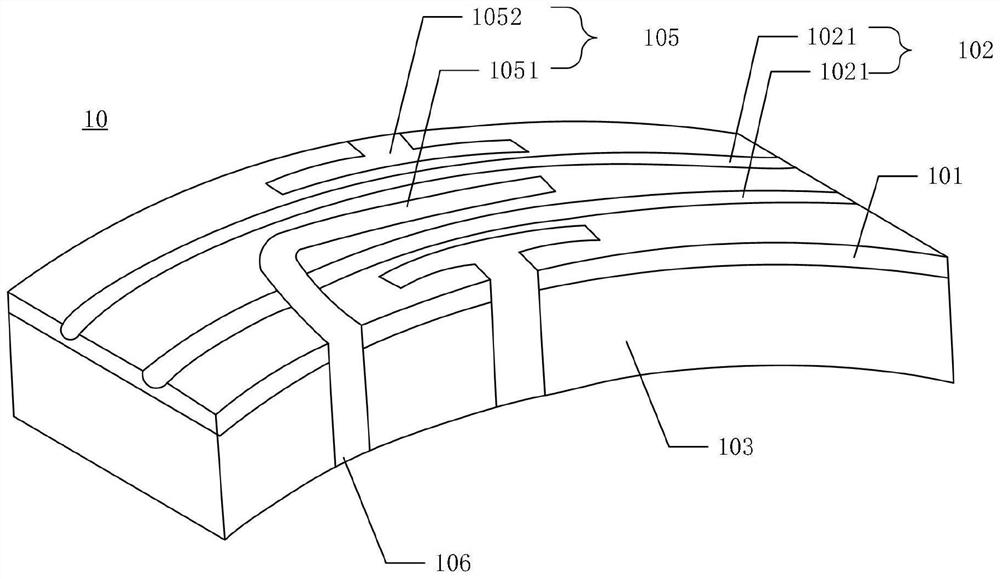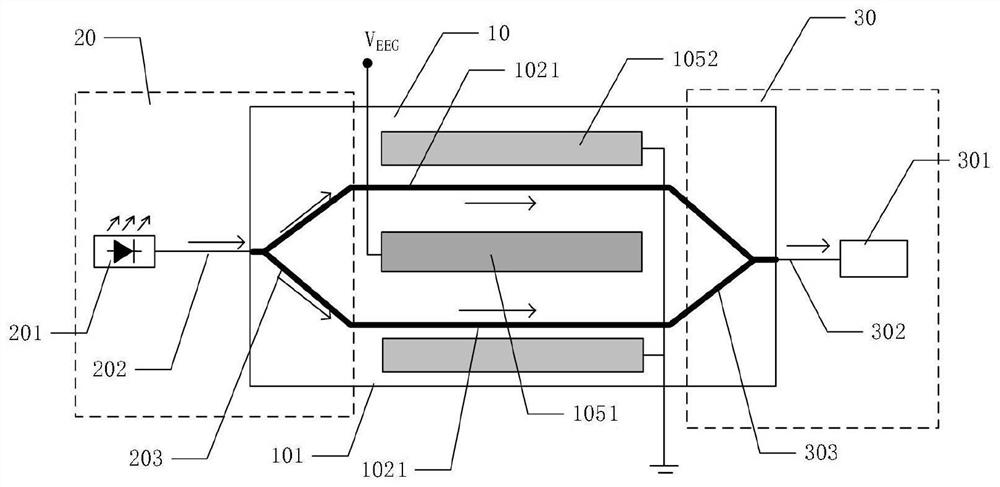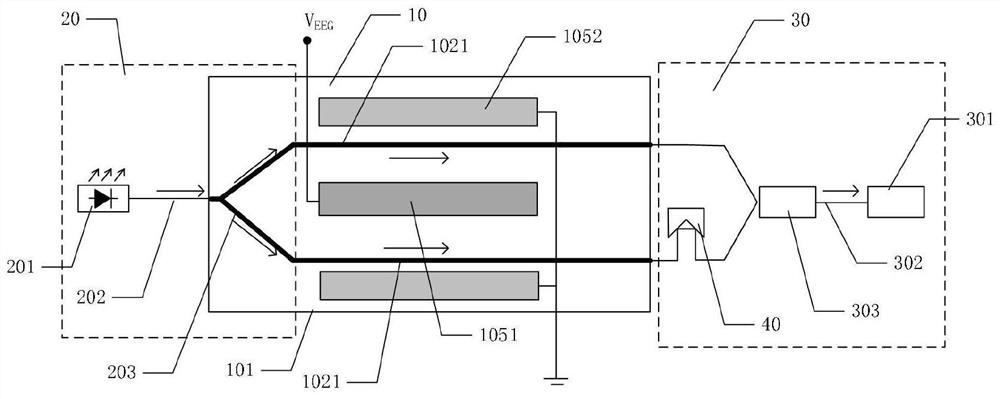Flexible lithium niobate film electroencephalogram detection chip and device thereof
A detection device and detection chip technology, applied in the field of biological sensing, can solve the problems of inflexibility, increase the probability of electromagnetic interference, and difficult to fit, and achieve the effect of not easy electromagnetic interference.
- Summary
- Abstract
- Description
- Claims
- Application Information
AI Technical Summary
Problems solved by technology
Method used
Image
Examples
Embodiment 1
[0056] Such as figure 2 As shown, a flexible lithium niobate thin film EEG detection device is provided, including: a flexible lithium niobate thin film EEG detection chip 10, the chip includes: a flexible lithium niobate substrate 101, on which a light waveguide 102 and coplanar traveling wave electrode 105; and flexible support layer 103 ( figure 2 Not shown in ), used to provide support for the flexible lithium niobate substrate 101; the surface of the flexible support layer 103 is provided with electrodes 106 ( figure 2 not shown in ), the coplanar traveling wave electrode 105 is connected to the electrode 106.
[0057] The optical waveguide 102 includes a set of waveguide interference arms 1021 , the center electrode 1051 of the coplanar traveling wave electrode 105 is located between each set of waveguide interference arms 1021 , and the ground electrodes 1052 are located on both sides of each set of waveguide interference arms 1021 .
[0058] Optical input assembly...
Embodiment 2
[0062] Such as figure 2 As shown, a flexible lithium niobate thin film EEG detection device is provided. The difference between this embodiment and embodiment 1 is that the optical fiber bundle structure 303 of this embodiment is an optical fiber bundle that is separately arranged with the flexible lithium niobate substrate. A phase delay device 40 is connected to one of the output optical fibers 302; the light wave emitted by the light source 201 is transmitted to the flexible lithium niobate Y waveguide by the input optical fiber 201, and the light wave is divided into two beams, and the EEG signal is transmitted to the coplanar traveling wave On the electrode, the light is transmitted from the waveguide through the modulation area where the refractive index changes, the optical path changes, and the phase changes at the same time, and is output through the output optical fiber 302, one of the light waves passes through the delay device 40, and finally the two output light w...
Embodiment 3
[0067] Such as Figure 4 As shown, a flexible lithium niobate thin-film EEG detection device is provided. The difference between this embodiment and embodiment 1 is that the optical fiber beam splitting structure 203 of this embodiment is an optical fiber beam splitter set separately from the flexible lithium niobate substrate. A phase delayer 40 is connected to one of the input optical fibers 202; the light wave emitted by the light source 201 is divided into two beams through the beam splitter, and one beam of light passes through the delayer 40 and is transmitted to the waveguide on the flexible lithium niobate substrate In the interference arm 1021, the EEG signal is transmitted to the coplanar traveling wave electrode 105, the optical path changes due to the change of the refractive index, and then the phase changes, and the light waves are combined by the Y waveguide and output by the output optical fiber 302, and the signal is transmitted to the remote end On the detect...
PUM
 Login to View More
Login to View More Abstract
Description
Claims
Application Information
 Login to View More
Login to View More - R&D
- Intellectual Property
- Life Sciences
- Materials
- Tech Scout
- Unparalleled Data Quality
- Higher Quality Content
- 60% Fewer Hallucinations
Browse by: Latest US Patents, China's latest patents, Technical Efficacy Thesaurus, Application Domain, Technology Topic, Popular Technical Reports.
© 2025 PatSnap. All rights reserved.Legal|Privacy policy|Modern Slavery Act Transparency Statement|Sitemap|About US| Contact US: help@patsnap.com



